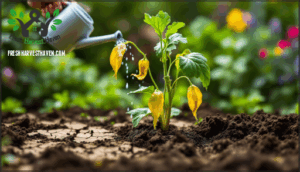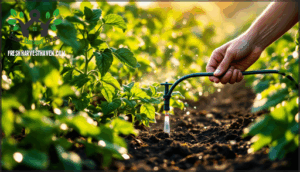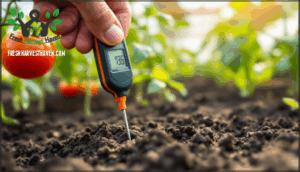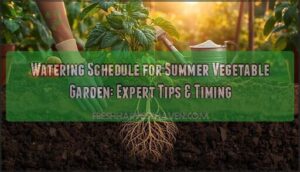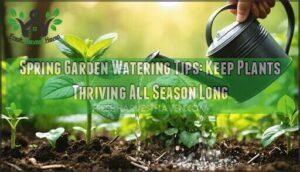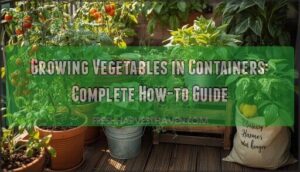This site is supported by our readers. We may earn a commission, at no cost to you, if you purchase through links.
 Most gardeners water their vegetables the same way—consistently and confidently wrong. They stand there with a hose every evening, spraying leaves until everything looks green and happy, then wonder why their tomatoes split, their squash gets powdery mildew, or their peppers barely produce.
Most gardeners water their vegetables the same way—consistently and confidently wrong. They stand there with a hose every evening, spraying leaves until everything looks green and happy, then wonder why their tomatoes split, their squash gets powdery mildew, or their peppers barely produce.
The difference between a struggling garden and a thriving one often comes down to technique, not effort. Your plants don’t need more water; they need smarter watering. Once you understand when, where, and how much to water based on your soil type and plant needs, you’ll spend less time with the hose and more time harvesting.
Table Of Contents
- Key Takeaways
- Essential Watering Techniques for Vegetables
- Avoiding Common Watering Mistakes
- Best Times and Schedules to Water
- Matching Watering to Soil and Plant Needs
- Tools and Tips for Efficient Watering
- Frequently Asked Questions (FAQs)
- What is the most efficient way to water a vegetable garden?
- How long should I run my sprinklers on my vegetable garden?
- What is the best time to carry out watering in vegetable garden?
- How to properly water your vegetable garden?
- Should I water my vegetable garden every morning?
- How often should I water raise my vegetable garden?
- How to water vegetables during extreme heat waves?
- Can rainwater affect my gardens watering schedule?
- What vegetables need less water than others?
- Should watering change during flowering and fruiting stages?
- Conclusion
Key Takeaways
- Deep watering at the base of plants (5-6 inches deep) encourages strong root growth and drought tolerance while preventing fungal diseases that thrive on wet foliage.
- Morning watering is optimal because cooler temperatures allow water to penetrate soil before evaporation, and foliage dries quickly to prevent disease—while evening watering leaves plants vulnerable to fungal infections overnight.
- Your watering schedule should adapt to soil type (sandy soil drains fast and needs frequent watering, clay holds moisture longer) and plant maturity (new plantings need daily water, established vegetables tolerate deeper, less frequent watering).
- Overwatering causes root rot and can reduce yields by 33%, while severe underwatering crashes production by 50-65%—checking soil moisture several inches below the surface prevents both extremes better than following rigid schedules.
Essential Watering Techniques for Vegetables
Watering vegetables the right way can make the difference between a struggling patch and a productive garden that practically feeds itself. You’ll find that a few solid techniques—applied consistently—protect your plants from disease, encourage deep roots, and save you time at the hose.
Let’s look at the essential methods that keep your vegetable garden healthy and thriving.
Deep, Infrequent Watering
When you water your vegetables deeply but less often, you’re teaching their roots to grow strong and reach far into the soil instead of staying shallow and weak. This approach improves drought tolerance and encourages healthy root growth.
Aim for a watering depth of 5 to 6 inches, checking soil moisture below the surface. Deep watering promotes better root development while conserving water and maintaining proper soil aeration.
Watering at The Base, Not Foliage
Your plant’s leaves are the last place you want water to land, since wet foliage invites fungal diseases and wastes water that should be feeding the roots below. Direct water at the soil level around each plant’s base to make certain targeted hydration reaches the root zone. This practice promotes root health, prevents soil splash onto leaves, and conserves water.
Here’s how to water garden plants effectively:
- Aim your watering wand or hose at the soil, not the foliage.
- Water slowly so moisture penetrates deeply without runoff.
- Keep leaves dry to minimize disease risks in vegetable gardens.
Using Soaker Hoses and Drip Irrigation
Soaker hoses and drip irrigation take the guesswork out of watering by delivering moisture slowly and directly to your plant roots.
You’ll conserve water, reduce disease risk, and save time by setting up a drip irrigation system with a timer on your vegetable garden beds.
Weave your soaker hose between plants, regulate water pressure to prevent leaks, and check for clogs monthly to keep your irrigation running smoothly.
Benefits of Mulching for Moisture Retention
A layer of mulch works like a blanket over your soil, locking in moisture and cutting your watering needs by nearly half.
Spread 2 to 3 inches of organic matter like straw or shredded leaves around your vegetable garden to regulate soil temperature, suppress weed control problems, and boost water retention throughout the growing season.
Avoiding Foliage Wetting to Prevent Disease
When you water from above, you’re giving fungal spores and bacteria a free ride onto vulnerable leaves where they can settle in and cause real damage.
Direct your watering methods at the base of your plants instead, keeping the foliage dry and improving air circulation around the leaf surface.
This simple shift in watering vegetable gardens cuts your risk of fungal diseases and bacterial spread dramatically.
Avoiding Common Watering Mistakes
Even experienced gardeners can fall into watering traps that harm their vegetables. Getting the balance right means knowing what to watch for and what advice to ignore.
Here’s what you need to avoid to keep your garden healthy.
Overwatering Risks and Signs
Too much water can quietly suffocate your plants, cutting off root oxygen and paving the way for root rot. Up to 80% of plant death in moist conditions stems from this oxygen deprivation, while waterlogging slashes vegetable yields by an average of 33%. You’ll notice yellowing leaves, limp stems, and edema signs like blistered tissue.
Nutrient leaching drains fertility, and disease susceptibility spikes—fungal infections and mold thrive in soggy soil, boosting crop failure by 30%. Using a rain gauge is important because one inch per week is generally enough for most plants.
Underwatering Effects on Plant Health
On the flip side, underwatering inflicts drought stress that crashes vegetable yields by 50–65% under severe deficits. Cellular damage from oxygen species disrupts membranes, while wilting, leaf rolling, and chlorophyll breakdown signal trouble. Disease susceptibility climbs 15–33% as weakened plants attract pests and pathogens. One early sign of this stress is plant flagging.
- Stunted growth can shrink final plant height by 35%, leaving you with disappointing harvests.
- Soil deterioration follows—compaction, slower decomposition, and 25% less microbial life cripple future crops.
- Watering schedule adjustments are essential; drought conditions demand consistent monitoring to protect plant health and growth.
Importance of Proper Drainage
Proper drainage isn’t just helpful—it’s the safety net that keeps your soil from becoming a plant graveyard. Without it, waterlogged roots suffocate, triggering root rot within days.
Clay-heavy soil compaction chokes root health, while sandy soil drains fast but needs drainage materials like gravel in containers.
Raised beds excel at preventing standing water—your best defense against watering disasters.
Watering Myths Debunked
You’ve probably heard that watering on sunny days causes leaf burn—but that’s pure fiction. Here are common watering myths that trip up even experienced gardeners:
- Leaf burn from water droplets acting as magnifying glasses doesn’t actually happen in real gardens
- The rigid "one inch per week" rule ignores your soil type, weather patterns, and plant needs
- Evening watering doesn’t guarantee disease if you target roots, not foliage
- Overwatering signs like yellowing leaves often get mistaken for nutrient deficiencies
- A consistent schedule matters less than checking soil moisture several inches down before watering
Adjust your watering techniques based on what your plants show you, not outdated gardening rules.
Best Times and Schedules to Water
Timing your watering makes a real difference in how well your vegetables grow and stay healthy. When you water matters just as much as how much you water, since it affects everything from disease prevention to nutrient absorption.
Let’s look at the best times to water and how to adjust your schedule as conditions change.
Morning Watering Benefits
The best time to water your vegetable garden is early morning, when cooler temperatures and calm air allow water to soak deeply into the soil before the sun climbs high. Morning watering also helps with disease prevention since foliage dries quickly in the sun, reducing fungal issues and offering natural pest deterrence throughout the day.
This watering schedule promotes efficient absorption with reduced evaporation, strengthening roots for stronger growth.
Dangers of Evening Watering
While morning watering sets your plants up for success, watering in the evening can invite trouble—wet leaves overnight create the perfect conditions for fungal diseases and pests to move in.
Reduced evaporation and cooler temperatures keep foliage damp for hours, encouraging fungal growth that weakens plants. Watering at night also attracts slugs and other pests drawn to moisture, making your garden vulnerable when it should be resting.
Adjusting Frequency for Weather and Growth
Your garden doesn’t run on a fixed schedule—plants need more water during scorching summer days and less when cool weather slows their growth. Hot, windy days increase evaporation rates, so you’ll water more often.
During the growing season, rapidly developing vegetables need consistent moisture, while mature plants tolerate drier spells better.
Watering Newly Planted Vs. Established Vegetables
Newly planted vegetables are like toddlers learning to walk—they need daily attention and steady support, while established plants act more like independent teenagers who can manage a few missed check-ins.
For the first week or two, water newly planted vegetables daily to support root establishment and nutrient uptake. Once roots take hold, gradually reduce frequency adjustments, shifting to deeper, less frequent watering that encourages stronger growth at different growth stages.
Matching Watering to Soil and Plant Needs
Not all soil drains the same, and not all vegetables drink at the same pace. Understanding your soil type and each plant’s needs helps you water smarter, not harder.
Let’s break down how to match your watering approach to what you’re actually growing.
Understanding Soil Types (Sandy, Clay, Loam)
You might think all dirt works the same, but that’s far from true. Sandy soil drains quickly and needs frequent watering, while clay soil holds water longer yet can become compacted and heavy. Loamy soil offers the best of both—good drainage and moisture retention.
Understanding your soil type helps you tailor watering schedules, avoid drainage problems, and choose the right soil amendments to keep your vegetable garden thriving.
Assessing Plant Water Requirements
Not all vegetables drink the same, and matching water to each plant’s needs saves you time, money, and heartache. Leafy greens need consistent soil moisture, while tomatoes prefer deep, less frequent watering once established.
Check specific vegetable needs and adjust watering frequency based on growth stage impact and environmental considerations. Monitoring soil moisture levels and visual plant cues—like wilting or leaf color—helps you respond before water requirements become plant health problems.
Container Vs. Garden Bed Watering
Containers dry out faster than garden beds, so watering strategies shift based on where your vegetables grow. Drainage differences and limited soil volume in containers mean you’ll water more frequently—sometimes daily in hot weather.
Garden beds hold moisture longer due to greater root space and soil contact.
Check container soil moisture an inch below the surface, and adjust watering techniques based on portability effects and root restriction.
Tools and Tips for Efficient Watering
The right tools make watering your vegetable garden easier and more precise. You don’t need fancy equipment, but a few smart choices can save you time and help your plants thrive.
Let’s look at some practical options that take the guesswork out of keeping your garden properly hydrated.
Using Moisture Meters for Accuracy
A moisture meter takes the guesswork out of watering, giving you a clear reading of what’s happening below the surface where your eyes can’t see. Insert the probe 4-6 inches deep for accurate soil moisture management. Check readings at multiple spots since watering patterns vary.
Here’s what to monitor:
- Sandy soil dries faster and needs more frequent meter checks than clay
- Probe depth placement matters—roots live deeper than you think
- Reading interpretation differs by vegetable type and growth stage
- Meter calibration keeps your soil moisture gauge reliable
- Meter maintenance includes cleaning the probe after each use to prevent corrosion
Selecting Watering Wands and Equipment
The right watering tool can turn a tedious chore into a more efficient task that saves your back and your time. Look for a watering wand with adjustable nozzle settings—gentle showers for seedlings, focused streams for deep watering.
Ergonomic wand design reduces hand fatigue during long sessions.
Choose durable hose material types like reinforced rubber over cheap vinyl, which kinks and cracks.
Monitoring Soil Moisture and Visual Plant Cues
Learning to read your garden like a book means knowing when to flip the page from "looks fine" to "needs water now." Check soil moisture levels by pressing your finger two inches deep—if it feels dry, it’s time to water.
Visual plant cues tell the story too: leaf color changes from vibrant green to dull gray-green, slowed growth rate, and early-morning wilting signs all signal thirst before serious damage occurs.
Setting Up Automatic Watering Systems
Installing a watering system that runs itself frees you from the daily routine and keeps your vegetables consistently hydrated, even when life gets busy. Here’s how to set one up:
- Choose drip irrigation systems or soaker hoses for direct root-zone watering and water conservation
- Add smart controllers to adjust your watering schedule based on weather conditions automatically
- Position emitters near plant bases, spacing them according to your soil type and plant needs
- Perform system maintenance monthly—check for clogs, leaks, and proper pressure to keep irrigation running smoothly
Conserving Water and Preventing Waste
Once your system addresses the basics, water conservation methods like mulching and smart watering practices make a real difference. Apply two to three inches of mulch around plants to reduce water waste and improve soil moisture retention.
Adjust your watering schedule based on rainfall and temperature, and use drip irrigation to deliver water exactly where roots need it, minimizing runoff and evaporation.
Frequently Asked Questions (FAQs)
What is the most efficient way to water a vegetable garden?
Deep watering transforms vegetable gardens from struggling patches to thriving ecosystems. Use drip irrigation or soaker hoses at the root zone, water early morning, and check soil moisture several inches down to encourage deep root growth while conserving water.
How long should I run my sprinklers on my vegetable garden?
Your sprinkler run time depends on soil type, sprinkler type, and weather conditions. Generally, aim for 30–60 minutes twice weekly to achieve proper soil saturation level and meet vegetable water needs without overwatering.
What is the best time to carry out watering in vegetable garden?
Water your vegetable garden early in the morning when soil temperature is cool and foliage can dry quickly. This timing reduces disease risk while maximizing moisture absorption.
Adjust watering frequency based on weather considerations, growth stages, and plant variety to maintain a healthy watering schedule.
How to properly water your vegetable garden?
Your garden thrives when you focus on watering frequency, proper watering practices, and soil drainage.
Check soil moisture before watering—stick your finger two inches deep. If it’s dry, water slowly at the base until you reach root depth.
Mulch benefits include reducing evaporation and regulating temperature.
Should I water my vegetable garden every morning?
You don’t need to water vegetable gardens every morning. Overwatering can harm root health and cause disease.
Check soil moisture first. Most established vegetables need watering once or twice weekly, depending on weather and soil conditions.
How often should I water raise my vegetable garden?
Like checking a pulse, you need to read your garden’s signals rather than follow a rigid schedule.
Water raised vegetable beds when the top inch of soil feels dry, usually once or twice weekly. Climate considerations, soil drainage, growth stage, plant type, and container size all affect watering frequency.
How to water vegetables during extreme heat waves?
During extreme heat waves, increase watering frequency to twice daily—early morning and late afternoon—to combat evaporation mitigation and soil temperature stress.
Apply shade cloth to reduce plant water stress, monitor for heat-stress signs, and focus on soil moisture management through deep watering at the root zone.
Can rainwater affect my gardens watering schedule?
Yes, rainwater directly impacts your watering schedule. Natural rainfall can reduce or eliminate the need for manual watering.
Check soil moisture after rain events, and adjust your watering techniques accordingly to prevent overwatering your garden plants.
What vegetables need less water than others?
Some vegetables thrive with minimal water. Drought-tolerant veggies like tomatoes, peppers, and eggplant tolerate drier conditions well.
Mediterranean vegetables, including rosemary and thyme, need infrequent watering.
Root vegetables adapt better to low-water schedules than leafy greens.
Should watering change during flowering and fruiting stages?
Most vegetables need consistent soil moisture during flowering and fruiting stages. Water deeply to prevent blossom end rot and water stress signs.
Fruiting water needs increase, so adjust your watering schedule to maintain even moisture without overwatering.
Conclusion
Your garden isn’t a slot machine—you can’t just pull the lever and hope for jackpots. Mastering watering tips for a thriving vegetable garden means moving past guesswork and into intentional care.
Water deeply at the base, adjust for your soil type, and watch your plants closely. The reward isn’t luck; it’s a garden that delivers consistent harvests because you gave it exactly what it needed, when it needed it.
- https://extension.umaine.edu/about/staff-directory/ankit-singh/
- https://landscape-water-conservation.extension.org/dangers-of-excess-water-on-xeric-landscapes/
- https://fieldreport.caes.uga.edu/too-much-water-for-plants-as-bad-as-not-enough/
- https://blogs.ifas.ufl.edu/osceolaco/2020/06/24/negative-effects-of-overwatering-plants/
- https://jomostudio.com/blogs/plant-with-jomo/the-mystery-of-overwatering-finding-the-right-balance-for-your-tropical-plants

